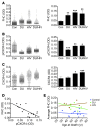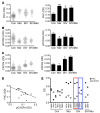Neuronal ferritin heavy chain and drug abuse affect HIV-associated cognitive dysfunction
- PMID: 24401274
- PMCID: PMC3904611
- DOI: 10.1172/JCI70090
Neuronal ferritin heavy chain and drug abuse affect HIV-associated cognitive dysfunction
Abstract
Interaction of the chemokine CXCL12 with its receptor CXCR4 promotes neuronal function and survival during embryonic development and throughout adulthood. Previous studies indicated that μ-opioid agonists specifically elevate neuronal levels of the protein ferritin heavy chain (FHC), which negatively regulates CXCR4 signaling and affects the neuroprotective function of the CXCL12/CXCR4 axis. Here, we determined that CXCL12/CXCR4 activity increased dendritic spine density, and also examined FHC expression and CXCR4 status in opiate abusers and patients with HIV-associated neurocognitive disorders (HAND), which is typically exacerbated by illicit drug use. Drug abusers and HIV patients with HAND had increased levels of FHC, which correlated with reduced CXCR4 activation, within cortical neurons. We confirmed these findings in a nonhuman primate model of SIV infection with morphine administration. Transfection of a CXCR4-expressing human cell line with an iron-deficient FHC mutant confirmed that increased FHC expression deregulated CXCR4 signaling and that this function of FHC was independent of iron binding. Furthermore, examination of morphine-treated rodents and isolated neurons expressing FHC shRNA revealed that FHC contributed to morphine-induced dendritic spine loss. Together, these data implicate FHC-dependent deregulation of CXCL12/CXCR4 as a contributing factor to cognitive dysfunction in neuroAIDS.
Figures






Similar articles
-
Morphine-Induced Modulation of Endolysosomal Iron Mediates Upregulation of Ferritin Heavy Chain in Cortical Neurons.eNeuro. 2019 Jul 31;6(4):ENEURO.0237-19.2019. doi: 10.1523/ENEURO.0237-19.2019. Print 2019 Jul/Aug. eNeuro. 2019. PMID: 31300544 Free PMC article.
-
Morphine increases brain levels of ferritin heavy chain leading to inhibition of CXCR4-mediated survival signaling in neurons.J Neurosci. 2009 Feb 25;29(8):2534-44. doi: 10.1523/JNEUROSCI.5865-08.2009. J Neurosci. 2009. PMID: 19244528 Free PMC article.
-
Chemokine CXCL12 induces binding of ferritin heavy chain to the chemokine receptor CXCR4, alters CXCR4 signaling, and induces phosphorylation and nuclear translocation of ferritin heavy chain.J Biol Chem. 2006 Dec 8;281(49):37616-27. doi: 10.1074/jbc.M607266200. Epub 2006 Oct 19. J Biol Chem. 2006. PMID: 17056593
-
Regulation of neuronal ferritin heavy chain, a new player in opiate-induced chemokine dysfunction.J Neuroimmune Pharmacol. 2011 Dec;6(4):466-76. doi: 10.1007/s11481-011-9278-3. Epub 2011 Apr 5. J Neuroimmune Pharmacol. 2011. PMID: 21465240 Free PMC article. Review.
-
Disruption of neuronal CXCR4 function by opioids: preliminary evidence of ferritin heavy chain as a potential etiological agent in neuroAIDS.J Neuroimmunol. 2010 Jul 27;224(1-2):66-71. doi: 10.1016/j.jneuroim.2010.05.006. Epub 2010 Jun 8. J Neuroimmunol. 2010. PMID: 20627326 Free PMC article. Review.
Cited by
-
Opioid Modulation of Neuronal Iron and Potential Contributions to NeuroHIV.Methods Mol Biol. 2021;2201:139-162. doi: 10.1007/978-1-0716-0884-5_13. Methods Mol Biol. 2021. PMID: 32975796 Free PMC article. Review.
-
Host genetic factors predisposing to HIV-associated neurocognitive disorder.Curr HIV/AIDS Rep. 2014 Sep;11(3):336-52. doi: 10.1007/s11904-014-0222-z. Curr HIV/AIDS Rep. 2014. PMID: 24996618 Free PMC article. Review.
-
Interactions of HIV and drugs of abuse: the importance of glia, neural progenitors, and host genetic factors.Int Rev Neurobiol. 2014;118:231-313. doi: 10.1016/B978-0-12-801284-0.00009-9. Int Rev Neurobiol. 2014. PMID: 25175867 Free PMC article. Review.
-
The Endolysosomal Transporter DMT1 is Required for Morphine Regulation of Neuronal Ferritin Heavy Chain.J Neuroimmune Pharmacol. 2023 Sep;18(3):495-508. doi: 10.1007/s11481-023-10082-x. Epub 2023 Sep 4. J Neuroimmune Pharmacol. 2023. PMID: 37661197 Free PMC article.
-
CXCL12-induced rescue of cortical dendritic spines and cognitive flexibility.Elife. 2020 Jan 23;9:e49717. doi: 10.7554/eLife.49717. Elife. 2020. PMID: 31971513 Free PMC article.
References
Publication types
MeSH terms
Substances
Grants and funding
- T32 MH079785/MH/NIMH NIH HHS/United States
- R21 MH097623/MH/NIMH NIH HHS/United States
- U24 MH100928/MH/NIMH NIH HHS/United States
- DA32444/DA/NIDA NIH HHS/United States
- P01 DA023860/DA/NIDA NIH HHS/United States
- U01 MH083506/MH/NIMH NIH HHS/United States
- R01 DA032444/DA/NIDA NIH HHS/United States
- R01 MH085666/MH/NIMH NIH HHS/United States
- R37 DA015014/DA/NIDA NIH HHS/United States
- DA15014/DA/NIDA NIH HHS/United States
- R01 DA015014/DA/NIDA NIH HHS/United States
- U24 MH100931/MH/NIMH NIH HHS/United States
- T32-MH078795/MH/NIMH NIH HHS/United States
- MH 085666/MH/NIMH NIH HHS/United States
- P30 CA056036/CA/NCI NIH HHS/United States
- DA023860/DA/NIDA NIH HHS/United States
LinkOut - more resources
Full Text Sources
Other Literature Sources
Medical
Research Materials

